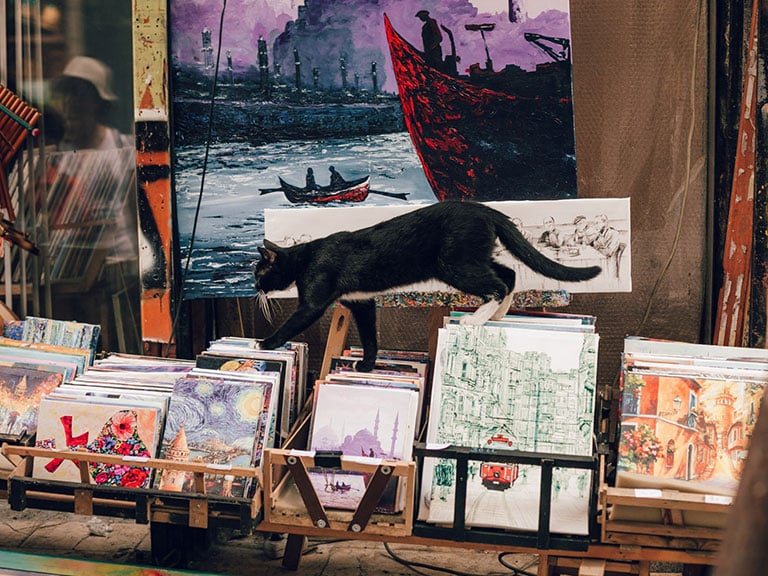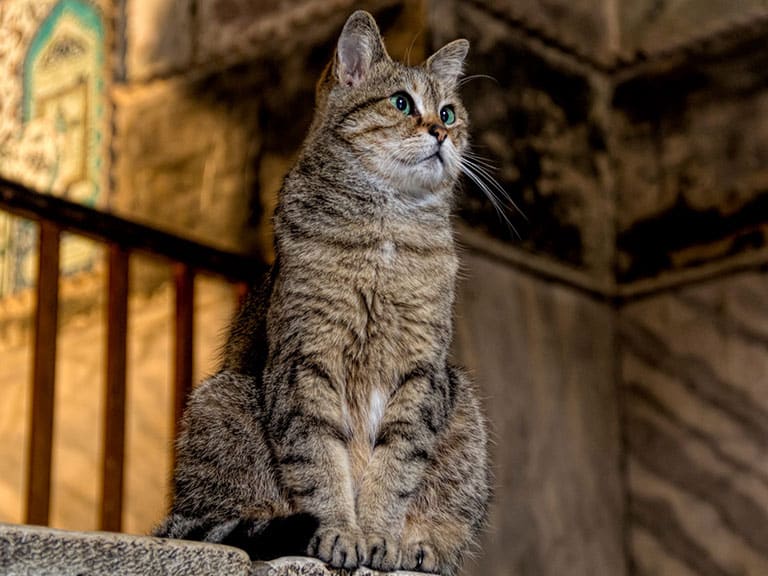Istanbul is not only home to hundreds of breathtaking attractions; it is also home to the largest concentration of stray cats you may see in any city. These cats can be seen wandering in almost every corner of the town, crossing streets, running on roofs, basking on statues, and playfully jumping between ledges. You will also find them beneath restaurant tables, asking for a small share of your delicious plate of Turkish cuisine. Some cats even grace Istanbul’s top attractions and have gained worldwide notoriety in the process.
You would think that with so many stray cats, many of them look filthy and emaciated, but it’s actually the other way round; Istanbul’s felines are well fed and clean and quite friendly. Therefore, do they belong to other tourists? If not, who takes such good care of them? Why are there so many cats, and where did they come from? Should you be alarmed when you encounter a cat outside your guesthouse at night? To get the answers to these and other lingering questions, stick with us as we explore these furry kings and queens of the streets of Istanbul.

Why Are There So Many Cats in Istanbul?
First, we put the cat population into context; Istanbul has over 16 million people and an estimated 160,000 cats wandering about its streets. These cats don’t belong to anyone in particular but rather belong to the city, and their large population is attributed to Islam, the dominant religion in the country.
Islam’s Fascination with Cats
Unlike in Christian Europe, where cats were once associated with witchcraft, Islam has always admired cats for their cleanliness. Therefore, these fluffy felines are thought to be ritually clean and, thus, honored. In Islamic traditions, they are allowed to enter mosques, and food touched by cats is still halal. Water drunk by a cat is also permitted for wudu.
In the Hadith, Prophet Muhammad banned the persecution and killing of cats. There is even a famous Islamic saying that says, “If you kill a cat, you need to build a mosque to be forgiven by God.” However, the Prophet also demonstrated a fondness for cats on multiple occasions, and one of his companions, Abu Hurairah (means father of the kitten), was known for this affection for cats.
In one account, Abu Hurairah’s pet cat saved the Prophet from a snake attack. According to the tale, the Prophet blessed the cat by giving them the well-known superpower of landing on their feet. Aby Hurairah also once claimed to have heard the Prophet declare that a woman went to hell for denying a kitten food and water. Another tale narrates that Muhammad once cut off his sleeve to avoid disturbing a cat sleeping on his robe when he had to rise for prayer.
In Islamic tradition, cats protected libraries and granaries from destruction by rats and mice and were thus considered guardians. By getting rid of rodents, they also helped protect the people from rat-borne plagues that would occasionally wreak havoc in the ancient world.
The result of this fascination
As a result of the religion’s teachings on cats, the felines gained a special place in the Ottoman and other Islamic empires of old. Cat loving monarchs like the 13th century Sultan Al-Zahir Baybars of the Mamluk even endowed a whole garden to the cats of his city where all their needs, including food, were catered for. Even when this garden was sold, the endowment stood, and people continued to take care of the cats in line with the King’s will.

How are cats treated now?
Cats were valued in the Ottoman Empire, and this tradition stayed strong even when Turkey became a republic. So naturally, the cat population thrived under the community care of entire cities like Istanbul; they are fed by everyone but belong to no one, maintaining their freedom. As you explore the city, small containers by the roadside are a standard feature. Here, the city’s inhabitants dish out portions of food to feed their furry neighbors.
Restaurant owners also feed the cats lurking around their establishments. Finally, some tourists refuse to be left behind in the noble tradition and occasionally drop some food to the felines, tentatively watching them underneath tables. All these factors combined have contributed significantly to the large number of cats roaming the streets of Istanbul.
Nonetheless, not all cats are on the right side of the city’s relationship with felines. In the poorer parts of the town, strays have it rough and are continually fighting for the little available food.
Are there any non-profit organizations that help these cats?
In addition to the efforts of residents of the city, there are numerous non-profit organizations in Istanbul aimed at helping stray cats. Some of these are established by locals or the government, while foreigners and international organizations have established others. To help the furry locals, these NGOs have started animal shelters and lobbied for better animal rights in the city.
For instance, malicious activities directed at cats and other animals were not punishable until 2004. Therefore, apart from glares by other residents, bad people would get away with animal cruelty without so much as a slap on the wrist. Efforts by lobbies and animal rights groups made the offense punishable by fines, and today, Turkey is introducing new laws that will make animal cruelty punishable by jail time.
Examples of non-profit organizations and animal shelters making life better for Istanbul’s feline population include:
Tails of Istanbul (TOI) organization
Tales of Istanbul is a non-profit that was founded by Therese, a Swedish traveler, in 2016. She came to the city to help refugees but found over a hundred abandoned cats in her shelter’s courtyard. The scenario inspired her to establish an organization that raises money for the veterinary care of the cats and awareness for their adoption.
Yedikule Animal Shelter
This is a shelter run by Fatih municipalities and volunteers.
Cihangir Cool for Cats
This is a volunteer group led by a British ex-pat and is actively working to save street animals around the city. Over the years, the organization has rescued thousands of animals from all over the city.
Forest Angels
This is another volunteer group working to protect stray dogs and cats living in the pockets of forests surrounding Istanbul.
HAYTAP
This is an animal rights organization based in Istanbul. Created in 2008, it is also a federation of other animal rights organizations based in Istanbul, and it unified all other similar organizations under one name. Its objective is to raise awareness on the violation of human rights in the city using public relations and education programs in school to spread its message. Today, the group is lobbying for stricter rules regarding animal cruelty.
Istanbul’s Cat Celebrities
The cat culture in the city has also led to the rise of beloved cat celebrities. Some of the most famous ones include:

1. Tombili
Tombili (Turkish for a chubby pet) was a famous street cat from Ziverbey in the Kadikoy district. She was loved for her friendliness and iconic pose while leaning against the steps. When photos of this pose went viral, the cat became a phenomenon in social networks worldwide, further elevating her position in Kadikoy. Unfortunately, Tombili fell seriously ill and died in early August.
After her death, 17,000 people signed a petition to honor her memory, which was accepted by the mayor of Kadikoy. As a result, a local sculptor made a statue recreating her famous pose. The sculpture was inaugurated on World Wildlife Day on 4th October 2016.

2. Gli
Gli was a Turkish best known for gracing the magnificent Hagia Sophia mosque. She was born in 2004 and raised in the Hagia Sophia, where she lived for 16 years. Throughout her lifetime, she was loved by tourists who visited and was a common symbol of the mosque. Her fame peaked when Barack Obama visited the mosque in 2009 and stroked the cat.
When the mosque was reopened in 2020, the cat regained her fame, and the internet was awash with her pictures taken by visiting tourists. She even had an Instagram account with 118,000 followers and a blog covering her life. On 7th November 2020, Gli died after receiving treatment and was buried in the Hagia Sophia premises.
Do they go well with the stray dogs in Istanbul?
Although cats may be the city’s famous furry inhabitants, dogs also roam the city in great numbers. In fact, the New York Times estimates that there are about 130,000 stray dogs in Istanbul alone. No, don’t be alarmed; the stray dogs in Istanbul are just as friendly as the cats of Istanbul. Also, the relationship between the cats and the dogs isn’t as violent as you would expect; they have learned to coexist in a relatively civil manner.
Nonetheless, dogs in Istanbul haven’t always had it easy. For the longest time, they didn’t receive as much care and attention as the cats. In fact, in the late 20th century and early 2000s, the city’s municipality poisoned dogs, which was not only inhumane but also paused a severe health hazard.
Since then, things have gotten better for the dogs. The same non-profit organizations taking care of stray cats in the city also take care of the dogs. The dogs are fed and vaccinated, so don’t freak out if one approaches you during your tour. New animal laws have also gone a long way in helping the canine inhabitants of Istanbul lead decent lives in the city streets.
Don’t forget to watch the cat movie!
In 2017, the documentary Kedi was released, exploring the lives of the Cats of Istanbul. The movie showcases how a day in the life of a cat goes and tells the residents’ opinions on their furry neighbors. Kedi finishes with a warning describing the dangers that the city’s rapid modernization poses to the cats of Istanbul.
